If you’ve been looking for an easy way to use up your excess sourdough discard, try this tasty gluten-free sourdough discard muffin recipe. This homemade gluten-free discard recipe is easy to follow, and you can make a batch in 35 minutes. They are delicious for breakfast, snacking, or packing in a lunchbox!
This post may contain affiliate links. Please read our Disclosure Policy.
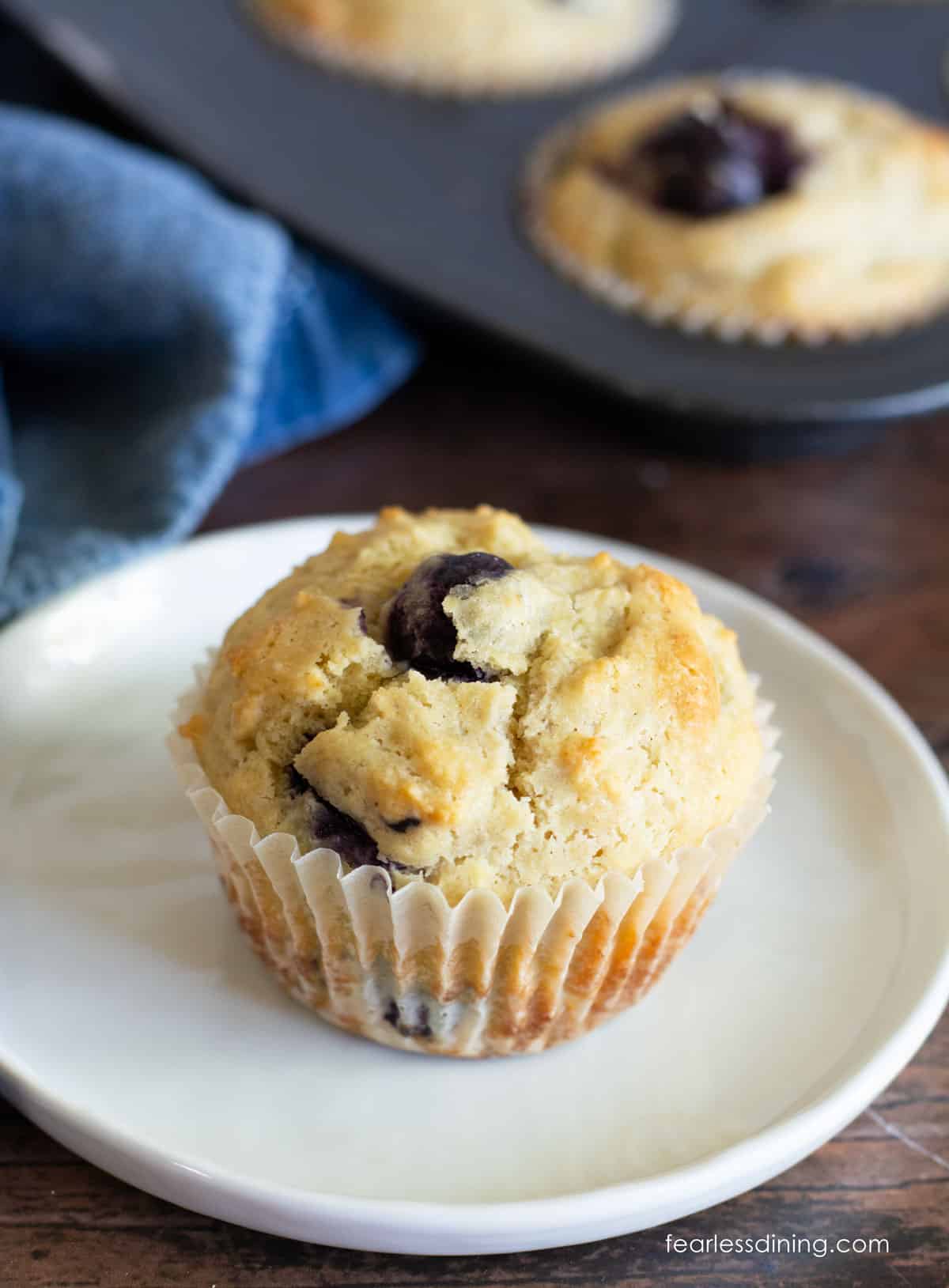
If you have been following my blog, you know I have gone down the rabbit hole of making sourdough recipes over the past two months. Making sourdough has become so much fun for me, but I have been accumulating a lot of gluten-free discard. These gluten-free sourdough discard muffins are spectacular. They are light, fluffy, and full of flavor!
This gluten-free discard muffin recipe, with a dairy-free option, is about to up your baking game! If you also love baking sourdough, check out all of my tasty gluten-free sourdough recipes! If you love bread, try my Gluten-Free Sourdough Discard Focaccia recipe. Also, try this easy Gluten-Free Sourdough Discard Scones recipe.
You can also make muffins with this Gluten-Free Lemon Blueberry Loaf with Sourdough Discard.
What sets my recipe apart:
Allergen Information:
These blueberry sourdough muffins are gluten-free, soy-free, nut-free, and oat-free. You can easily make this recipe dairy-free using a plant-based butter like Smart Balance. Although I haven’t tested an egg replacer in this recipe, many of my readers have written that Just Egg works well in my muffin recipes.
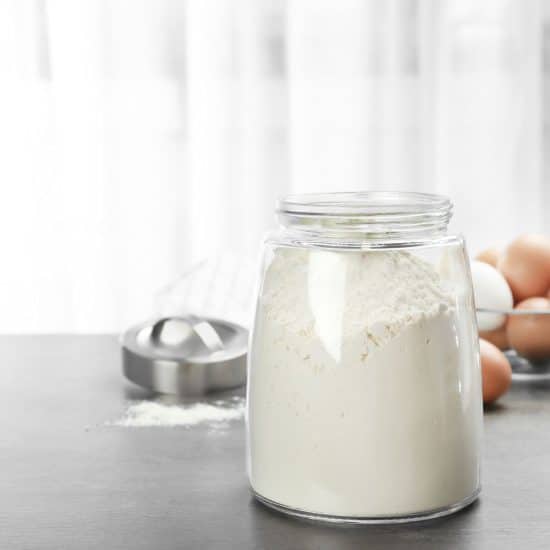
Flour Blends Tested:
1. King Arthur Measure for Measure—This blend works really well in muffin recipes. I don’t have to let the flour blend rest in the batter with this blend.
2. Bob’s Red Mill 1:1 Blend—This blend also works well, but this flour blend does benefit from resting the batter for 15 minutes before baking the muffins. The rest allows the rice flour in this blend to soften, so you don’t have gritty muffins.
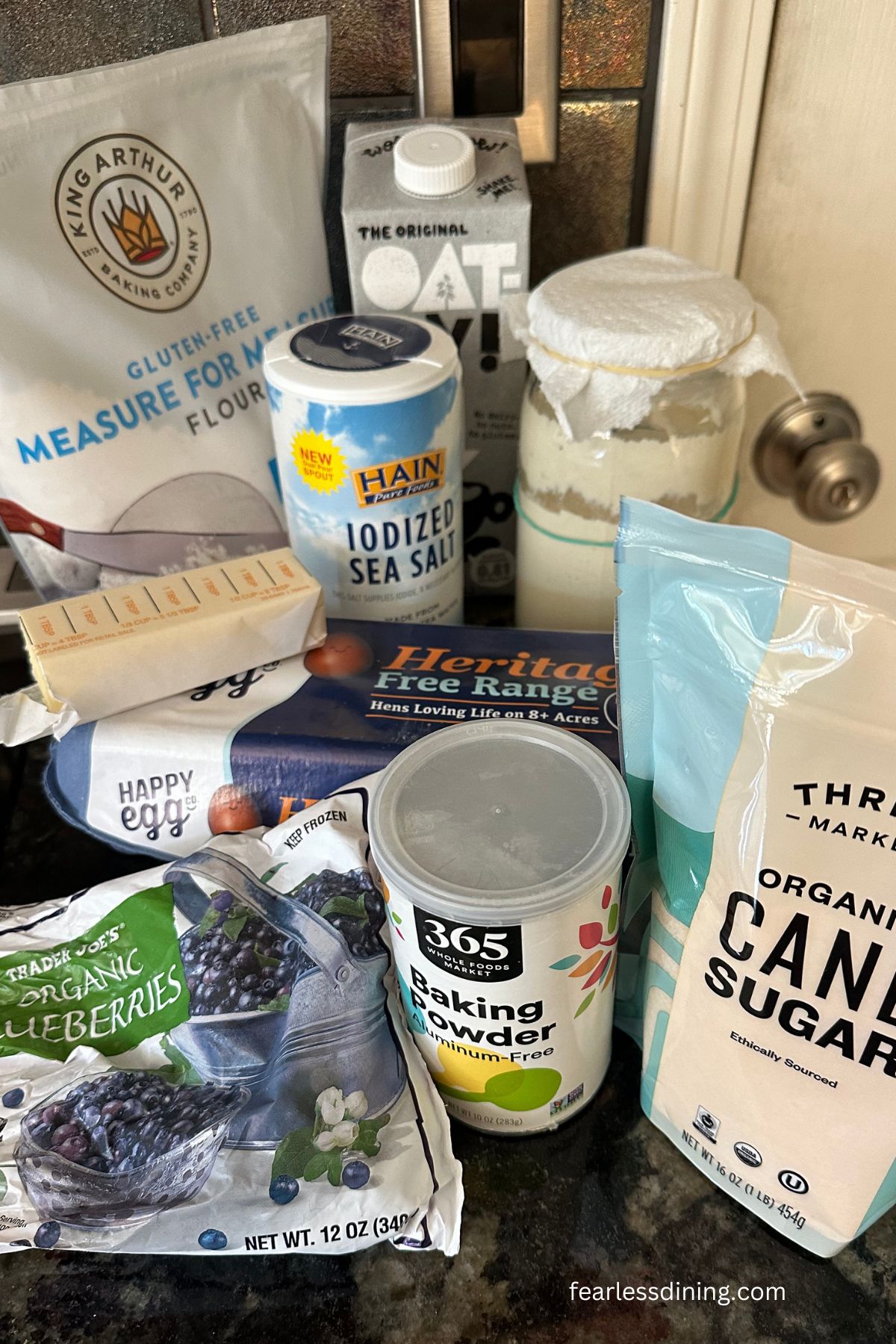
Ingredient Notes:
For the full list of ingredients and amounts, please go to the recipe card below.
- Gluten-Free Flour Blend – I discussed the flour blends tested in this discard muffin recipe. For more ideas on what flour blends are best for gluten-free muffins, I tested four popular gluten-free flour blends in my Gluten-Free Muffin Base Recipe. Any of these tested blends will work in this recipe.
- Xanthan Gum – The flour blends I tested had a binder like xanthan gum. If your flour blend doesn’t have a binder, you will need to add 1/2 teaspoon to your dry ingredients. If you can’t tolerate xanthan gum, you can try another binder. In this article, I discuss the different gluten-free binder options for baking.
- Baking Powder – I recommend using aluminum-free baking powder.
- Eggs – I use size large eggs for my baking.
- Sourdough Discard—You need to use a gluten-free sourdough discard. If you don’t have any extra discard, use an unfed sourdough starter. To learn how to make a sourdough starter, read my Gluten-Free Sourdough Starter recipe.
- Butter – I recommend using unsalted butter.
- Non-Dairy Milk – I used Oatly oat milk to make these muffins. Any non-dairy milk will work. You can also use regular milk.
- Blueberries – You can use fresh or frozen blueberries. Do not thaw frozen blueberries, or your muffins will turn purple. I share a lot more delicious mix-in ideas below.
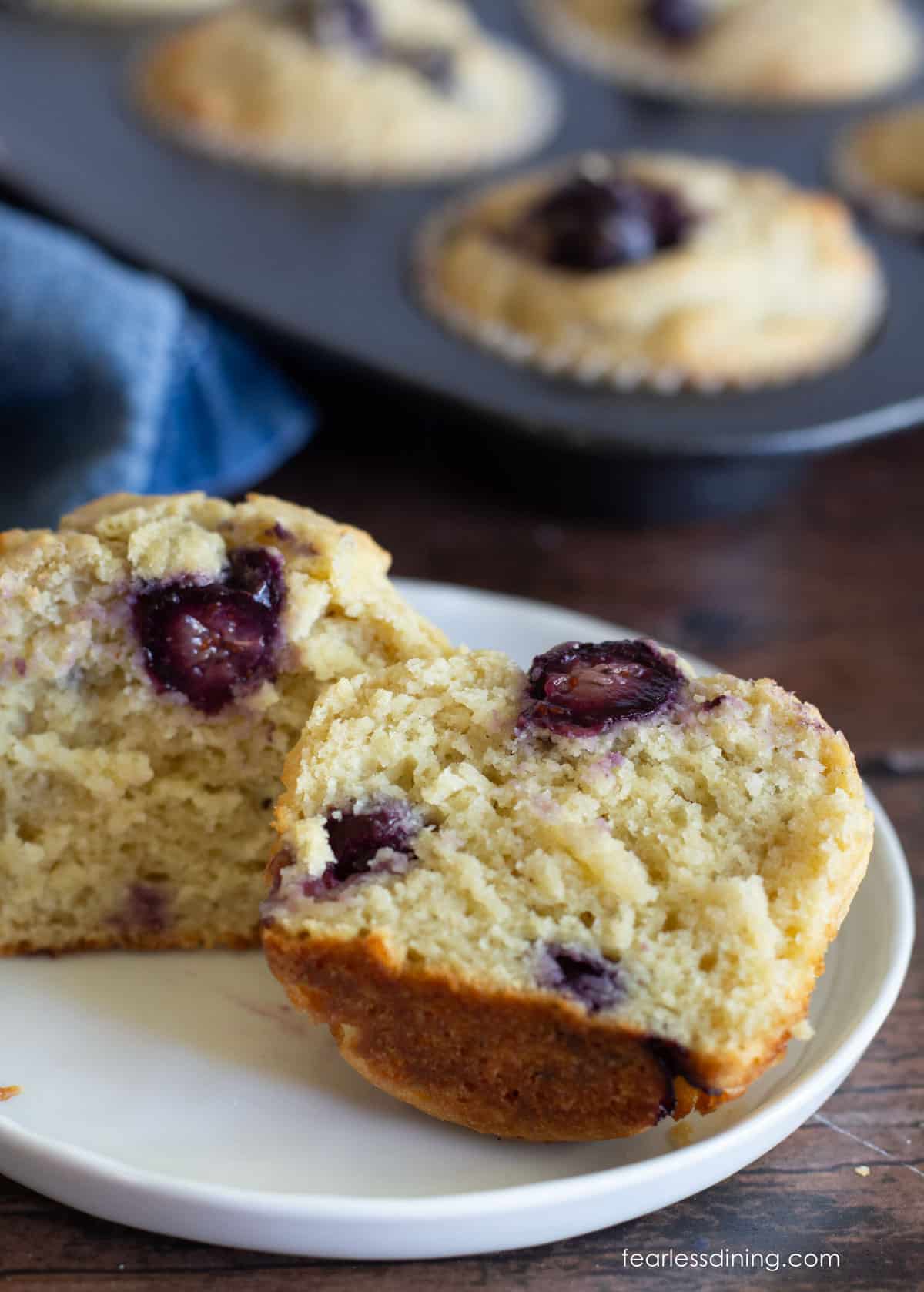
My tips for bakery-quality muffins:
1. For best results, mix the batter with a large spoon until the ingredients are “just barely mixed.”
2. Do not use a stand mixer to make muffin batter. It tends to overmix the batter, leaving you with denser muffins.
3. Always check the expiration date on the baking powder and soda, depending on which the recipe calls for.
4. I recommend baking your muffins with a conventional oven setting. Place the oven rack in the middle of the oven. This will ensure your muffins bake evenly. I don’t use the convection setting for baking muffins because it can dry them out.
5. For a dome muffin top, preheat the oven to 425º F. Bake the muffins at this high temperature for 5-6 minutes, then turn the oven temperature down to 350º F.
Step-By-Step Photos and Directions:
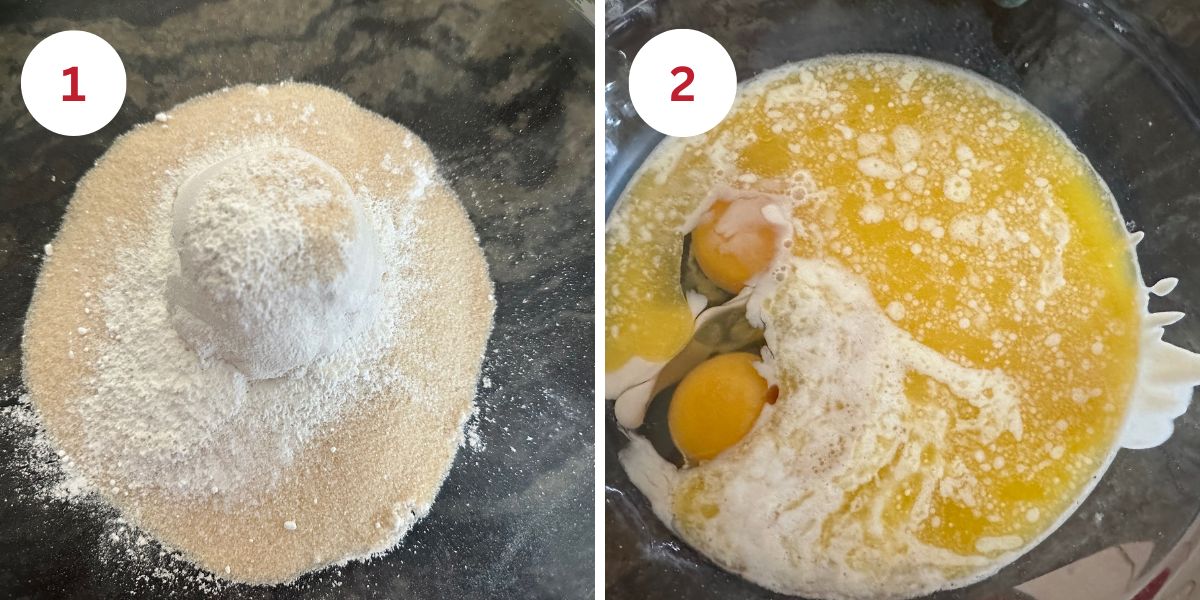
Step 1: Preheat the oven to 425º F if you are making dome-top muffins or 350º F if you are making regular muffins.
Add gluten-free flour, white sugar, baking powder, and salt in a large
Step 2: In a separate small bowl, add the eggs, melted butter, vanilla extract, sourdough discard, and non-dairy milk. Whisk the wet ingredients to blend. Note, when melting your butter, do not melt it too much, or it will be very hot, and cook your eggs. I microwave my butter in a microwave-safe dish for about 25 seconds.
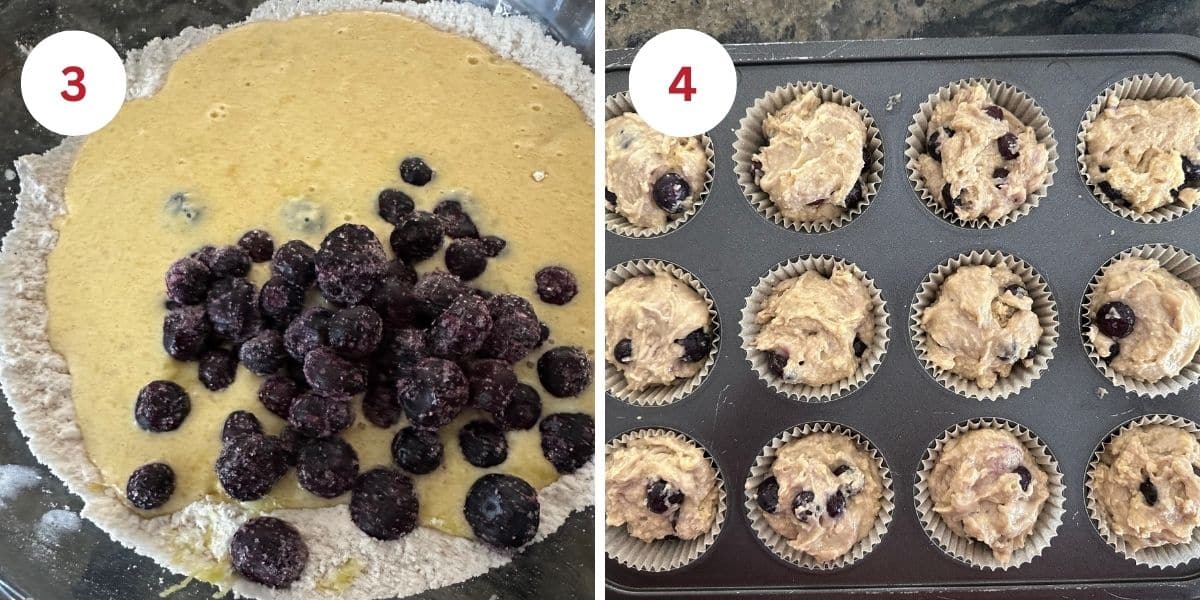
Email This Recipe To Me!
Step 3: Pour the wet ingredients into the dry ingredients. Add the blueberries. Don’t forget, if you use frozen blueberries, don’t thaw them; just add them to the bowl.
Mix the ingredients gently with a large spoon until they are just barely mixed. See my Bakery-Quality Muffin Tips section above for more information on why this is important. This is the secret for fluffy gluten-free muffins!
📢 Sandi says: Every gluten-free flour blend has a different starch-to-grain ratio. The brand of gluten-free flour you use will affect the moisture of the batter. If your cake batter is too runny, add more flour, and if it is too thick, add more liquids.
Read Why Gluten-Free Flour Blends Vary to learn more about this.
Step 4: Line a muffin pan with parchment paper liners or spray the tin with a gluten-free baking spray. I prefer using parchment paper liners because they are easy to use, and the muffin batter won’t stick to the paper. Fill each cup 3/4 full of muffin batter. If you want a larger muffin top, you can fill the papers all the way with batter.
Note: I used frozen blueberries so my batter is a lot colder/thicker than it would be using fresh blueberries.
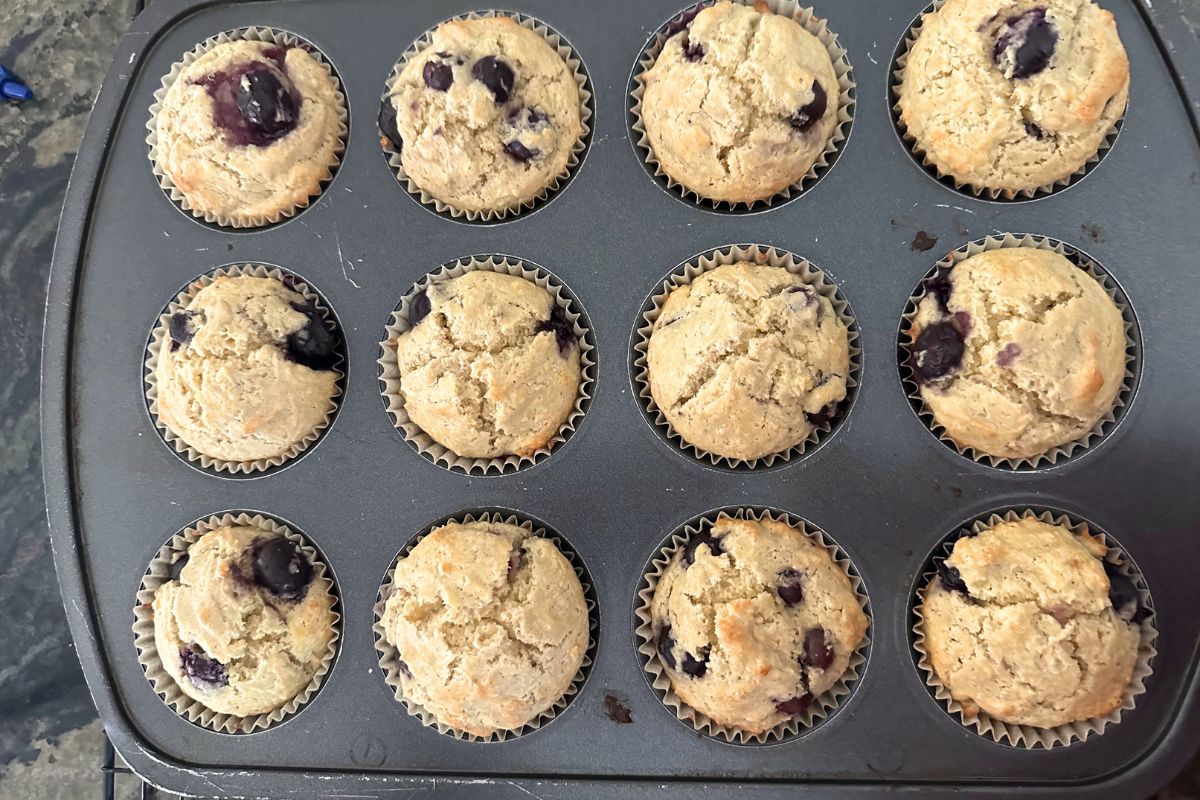
Step 5: Bake the muffins for 5 minutes at 425º F if you are making big muffin tops. Then turn the oven temperature down to 350º F. If you are baking them without the big muffin tops, bake at 350º F for 22-25 minutes.
The actual baking time can vary depending on how much you fill the muffin papers, if you use frozen or fresh blueberries, and the material of the baking pan you use.
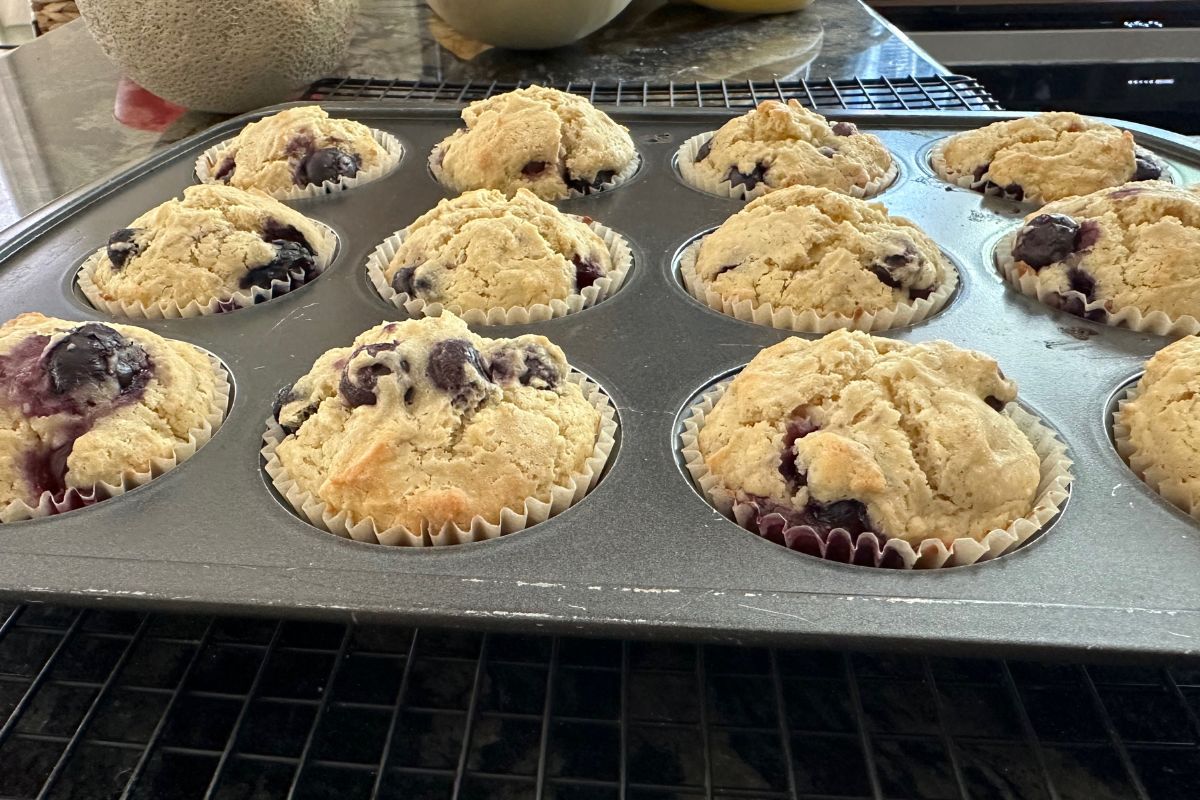
Step 6: Remove the muffins from the oven. Test the muffins with a toothpick to see if they are finished baking. Insert the toothpick in the center of the muffins, away from any mix-ins. If the toothpick comes out clean, the muffins are finished baking. If you see crumbs or batter on the toothpick, you will need to bake them a little longer.
Step 7: Let the muffins sit in the muffin pan for 3-4 minutes, then remove them to a cooling rack. Serve when they are cooled.
If you have more discard to use up, try this easy Gluten-Free Sourdough Discard Banana Bread.
Try these fun mix-ins:
This is the perfect sourdough muffin base recipe to add any type of mix-ins! Here are some of our favorites:
- Add chocolate chips…this is my kids’ favorite muffin add-in.
- Add walnuts or pecans for a little protein boost.
- Try other fruits like cherries, strawberries, raspberries, and blackberries.
Frequently Asked Questions:
Because we are not using the sourdough to rise these muffins, the discard primarily adds flavor and moisture to the muffins.
Sourdough discard can last a long time in the refrigerator. As long as you don’t see mold or smell a bad smell coming from the jar, you should be able to pour off the hooch and use it.
If your muffins didn’t rise, you want to check the expiration date of your baking powder. Expired baking powder is one of the biggest reasons for flat muffin tops. Another potential reason is opening the oven door. When baking muffins and cake, it is important to leave the oven door closed. A drop in temperature from the oven door opening can cause the muffins to sink.
If your muffins are dry or crumbly, you probably used a flour blend I didn’t test, and you didn’t add extra moisture if your batter was thicker. The grain-to-starch ratio is a huge factor because it affects the moisture levels.
If you need more help, check out my Gluten-Free Muffin Troubleshooting Guide. You can also reach out to me via my contact page with any questions. I am happy to help.
Storing/Freezing Instructions:
Store leftover sourdough muffins in an airtight container. They will stay fresh for up to 2-3 days, depending on the time of year. In the summer months, they can spoil a lot faster. My favorite way to store leftover muffins is in the freezer. Place the cooled muffins in a freezer bag, squeeze out the extra air, and place the bag in the freezer.
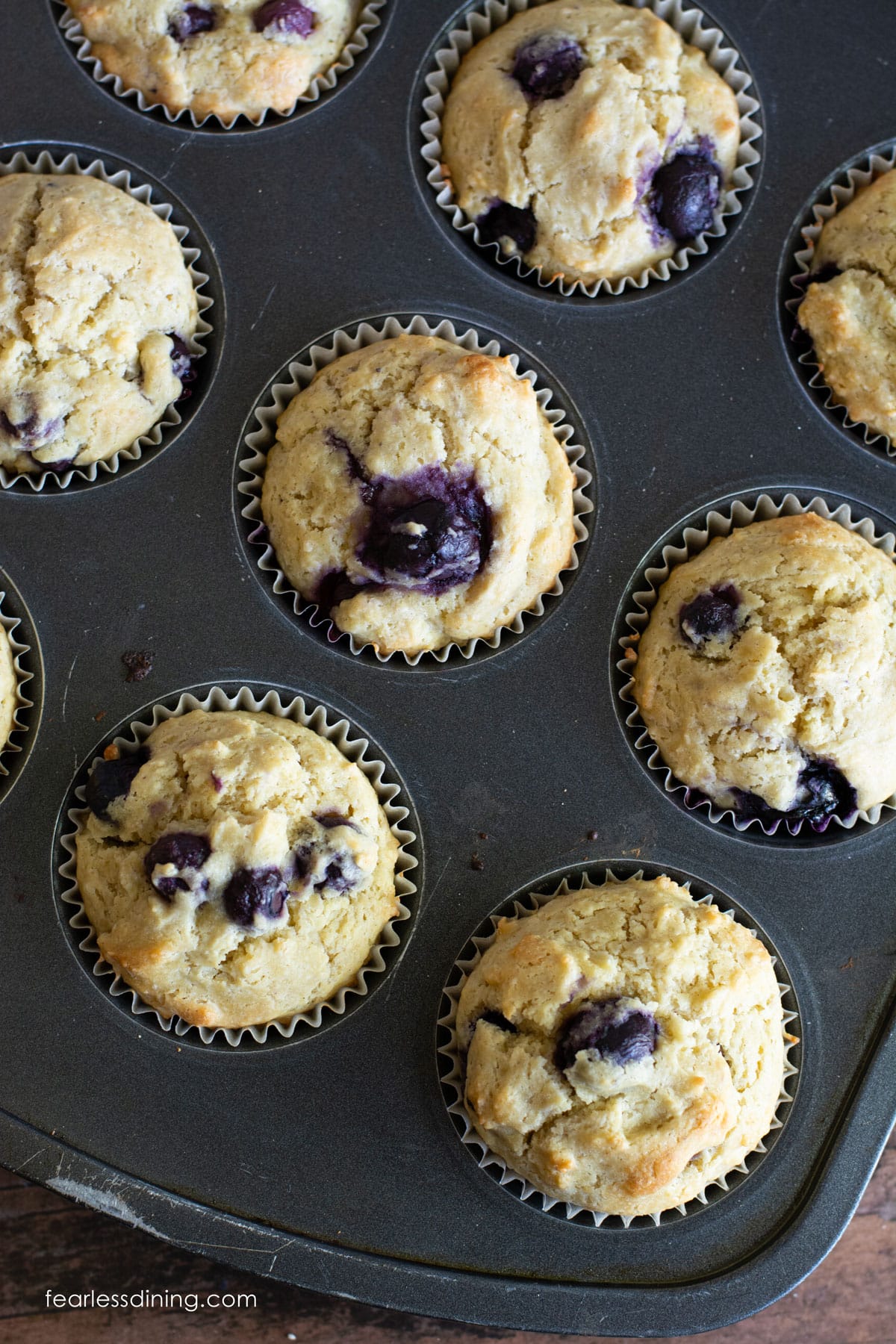
More Gluten-Free Muffin Recipes:
- Gluten-Free Apple Muffins – Full of fresh cinnamon apple flavor!
- Gluten-Free Cruffins – A cross between a croissant and a muffin!
- Fluffy Gluten-Free Banana Muffins – They are full of ripe banana flavor!
- These savory Gluten-Free Cheddar Herb Muffins are delicious with a bowl of soup or stew!
Love This Recipe?
If you made and enjoyed this recipe, I would be incredibly grateful if you could leave a comment below. Please include which flour blend you used. This helps others know that this recipe is delicious. Thank you!

Gluten-Free Sourdough Discard Muffins
Ingredients
Method
- Preheat the oven to 425º F if you are making dome-top muffins or 350º F if you are making regular muffins.
- Add 1 ½ cups gluten free flour blend, 3/4 cup cane sugar, 2 teaspoons baking powder, and 1/4 teaspoon salt in a large mixing bowl. Whisk the dry ingredients to combine. I like using a whisk because it blends the dry ingredients better than a spoon.
- Add the 2 large eggs, melted 6 tablespoons unsalted butter, 1 teaspoon pure vanilla extract, ½ cup gluten free sourdough starter, and 3/4 cup non-dairy milk in a separate small bowl. Whisk the wet ingredients to blend. If your discard is cold and thick, whisk it separately in the milk to help liquefy it.
- Note, when melting your butter, do not melt it too much, or it will be very hot, and cook your eggs. I microwave my butter in a microwave-safe dish for about 25 seconds.
- Pour the wet ingredients into the dry ingredients. Add the 1 cup blueberries. Don't forget, if you use frozen blueberries, don't thaw them; just add them to the bowl. If you use frozen blueberries, know that your muffin batter will be very cold and look thicker than if you use fresh blueberries.
- Mix the ingredients gently with a large spoon until they are just barely mixed.
- Line a muffin pan with parchment paper liners or spray the tin with a gluten-free baking spray. I prefer using parchment paper liners because they are easy to use. Fill each cup 3/4 full of muffin batter. If you want a larger muffin top, you can fill the papers all the way with batter.
- Bake the muffins for 5 minutes at 425º F if you make big muffin tops. Then turn the oven temperature down to 350º F. If you are baking them without the big muffin tops, bake at 350º F for 22-25 minutes.
- The actual baking time can vary depending on how much you fill the muffin papers, whether you use frozen or fresh blueberries and the baking pan material you use.
- Remove the muffins from the oven. Test the muffins with a toothpick to see if they are finished baking. Insert the toothpick in the center of the muffins, away from any mix-ins. If the toothpick comes out clean, the muffins are finished baking. If you see crumbs or batter on the toothpick, you will need to bake them a little longer.
- Let the muffins sit in the muffin pan for 3-4 minutes, then remove them to a cooling rack. Serve when they are cooled.
- Store leftover sourdough muffins in an airtight container. They will stay fresh for up to 2-3 days, depending on the time of year. In the summer months, they can spoil a lot faster. My favorite way to store leftover muffins is in the freezer. Place the cooled muffins in a freezer bag, squeeze out the extra air, and place the bag in the freezer.
Nutrition
Notes
- I tested this recipe with King Arthur Measure for Measure and Bob’s Red Mill 1:1. Other blends should work, but note that every gluten-free flour blend has a different starch-to-grain ratio. The brand of gluten-free flour you use will affect the moisture of the batter. If your cake batter is too runny, add more flour, and if it is too thick, add more liquids. Read Why Gluten-Free Flour Blends Vary to learn more about this.
- If your flour blend doesn’t contain a binder, add 1/2 teaspoon of xanthan gum.
- Use a gluten-free sourdough starter. If you don’t have any starter stored in your refrigerator, use an unfed starter. If you want to learn how to make a starter, read my Gluten-Free Sourdough Starter Tutorial.
- Make this recipe dairy-free using plant-based butter.
- You can use any fruit, chocolate chips, nuts, or other mix-ins in this muffin recipe.
Nutritional Disclaimer
Nutritional information is an estimate provided to you as a courtesy. You should calculate the actual nutritional information with the products and brands you are using with your preferred nutritional calculator.
Tried this recipe?
Let us know how it was!

These were excellent. I used fresh blueberries and regular milk. Next time I’ll add lemon zest and lemon in place of some of the other liquid.
I am really glad you loved these sourdough muffins. Thank you so much!
I just made these with my gluten free sourdough discard and they came out fabulous! I used almond milk, chopped in frozen strawberries plus used a mixture of cane sugar, brown sugar and coconut sugar (all equalling the 3/4 cup). They came out light and tasty. I will make them again. Thanks so much!
I am so glad you loved the these muffins. They are a family favorite for us!
Just pulled these muffins out of the oven and they are so delicious! I used King Arthur 1:1 gluten free flour and King Arthur Bread flour Sourdough starter. I will definitely be making these again.
I am so glad you loved this muffin recipe. Thank you so much, Andrea!
Can I use dairy free butter (well, it’s not butter), but you know what I mean. I have to be dairy free too.
Dairy-free butter should work just fine, enjoy!